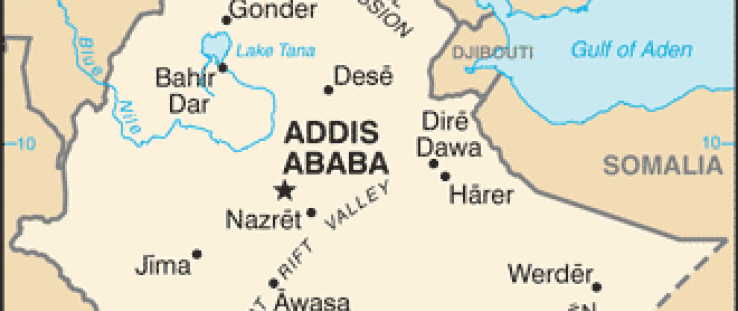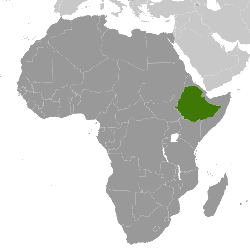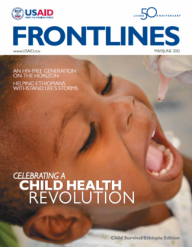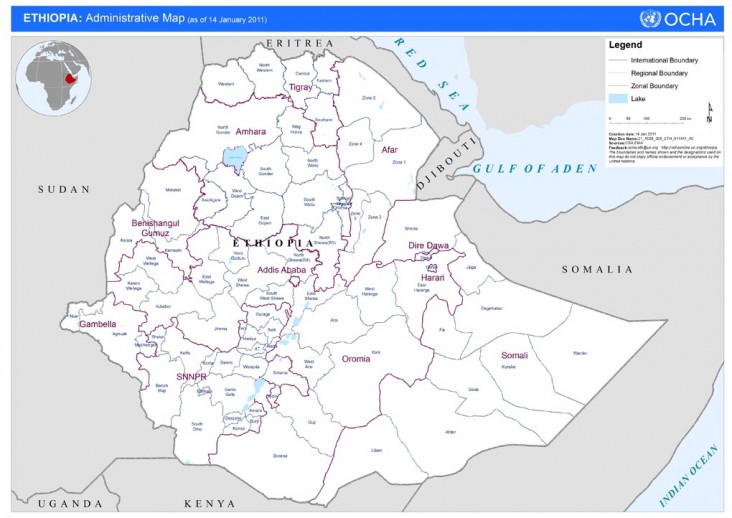 Map of Ethiopia
CIA Factbook
Map of Ethiopia
CIA Factbook
 Map of Ethiopia
CIA Factbook
Map of Ethiopia
CIA Factbook
Ethiopia is among the 10 poorest countries in the world but also among its fastest growing economies. These two facts combine to make it a compelling focus for U.S. development assistance. There is great need, tremendous potential and measurable progress. These confounding facts also make USAID’s portfolio of humanitarian and development programs in Ethiopia one of the largest and most complex in Africa.
Agriculture and rural development is the engine of Ethiopia’s growth and a healthy, educated population is the driver of the country’s transformation.
This issue of FrontLines features programs in Ethiopia that reinforce the impact of each to promote food security and agricultural sector growth, family health, basic education and peaceful resolution of conflicts—key elements for sustained development—and provide insight into how USAID supports a nation’s best efforts to progress.
In a country like Ethiopia, modern comforts are still challenges for many people, particularly those in rural areas where 85 percent of the population resides—things like piped water, easy transportation, electricity and Internet access. Progress is evident: Looking back just five years, now far fewer children are dying before age 5, more people are food secure, most children start school, many miles of roads cover the country, and numerous diverse businesses and banks are growing.
The Lay of the Land
With over 80 million inhabitants, the second most populous country in Africa is composed of diverse ethnic groups and religions. Among the most prominent are orthodox Christian and Muslim. Over 80 percent of the country’s population resides in rural areas and relies on subsistence agriculture. Geographically, Ethiopia covers a land mass equivalent to the U.S. states of Texas, Oklahoma and New Mexico. Its topography ranges from the highlands with its capital, Addis Ababa, the third highest in the world, to the Rift Valley and dry lowlands, including the lowest point in Africa below sea level, the Danakil Depression.
Situated in the Horn of Africa, just across the Red Sea from Yemen, bordered by Kenya, Djibouti, Somalia, Sudan, South Sudan and Eritrea, the country plays a pivotal role in regional peace-keeping and security. A healthy and prosperous Ethiopia has a great contribution to make to stability and economic progress in the Horn of Africa and, as such, is an important trading partner and security ally for the United States.
The stories on the following pages narrate how USAID programs impact the lives of Ethiopian farmers, health-caregivers, teachers, parents and entire communities around the country.
Moving Beyond Relief to Development
Despite the regular and increasingly more frequent cycle of droughts in parts of the country, the number of beneficiaries requiring emergency food aid or other humanitarian assistance has dropped from 15 million in 2003 to approximately 5.6 million, due largely to Ethiopia’s Productive Safety Net Program (PSNP). Operating since 2005, PSNP has changed the way chronic food insecurity is addressed. Under the program, USAID, along with other donors and the Ethiopian Government, now provides predictable and timely transfers of cash and food in exchange for building public works—terracing hillsides against erosion, or building check dams, canals, or access roads—that protect natural resources, provide irrigation, or ease access to markets.
Another important contribution to food security is guaranteeing that farmers and their dependents enjoy the fruits of their labor. USAID’s cooperation with the government, the sole landowner in Ethiopia, on land administration and certification has led to 165,000 households—including households headed by women—receiving land use rights. The heads of these households are confidently making investments in their property, and productivity gains are following suit.
Additionally, the U.S. Feed the Future initiative has expanded USAID’s already established technical assistance and training for cooperatives, allowing small-scale farmers to pool their scarce resources and knowledge. Now, these farmers routinely outperform farmers working on their own.
Access to credit is another critical element for growth among small entrepreneurs. USAID’s Development Credit Authority, through guarantees with private banks, opens up credit to farmers and rural entrepreneurs, and, importantly, to women borrowers, who face barriers when asking private banks for loans.
As Ethiopia endeavors to harness the untapped potential of its agricultural sector to create food security, jobs and growth, it also struggles to meet the health-care and education needs of its growing population and labor force.
Ethiopia’s Health Extension Program is a model closely watched by countries all over the continent. USAID’s Integrated Family Health Program works side by side with these health workers in 286 districts of the country covering over 32 million people. Largely as a result, Ethiopia has decreased under-5 child deaths by 28 percent—saving over about 80,000 children a year—since 2005.
With support from USAID and other donors, Ethiopia has achieved 95 percent enrollment in primary school over the past 15 years, yet an estimated 3 million primary school-aged children and over 20 million youth are outside the formal school system. USAID has worked with under-served communities to build Alternative Basic Education Centers, where students not only access education for the first time, but are also often outperforming students in the formal system.
Lastly, peace and progress are inextricable, and so USAID’s work to mitigate conflict and promote good governance is integral to its work. In particular, the southern half of the country is vulnerable to largely resource-based inter-communal conflict and administrative boundary disputes. The Negele Peace Accord, shows how USAID’s conflict resolution program has had great success in assisting local government and communities to negotiate and consolidate peace agreements and to ensure that administrative actions “do no harm.”
In Ethiopia, much progress has been made since the overthrow of the communist dictatorship, known as the Derg, in 1991. With each round of gains, there are successive challenges. Today, through the U.S. Feed the Future, Climate Change, and Global Health Initiatives, and through support to basic education, public accountability and conflict resolution, USAID is working with many international and Ethiopian partners to accelerate Ethiopia’s transformation away from extreme poverty toward prosperity.

Ethiopia
- Population: 82.9 million (2010)
- Population living at national poverty line: 38.9% (2009)
- Population growth: 2.6% per year (2007)
- Total fertility rate: 4.8 children per woman
- Contraceptive prevalence rate: 28.6 percent
- Maternal mortality rate: 676 per 100,000 live births
- Under 5 mortality rate: 88 per 1,000 live births
- Unemployment: 20.5% (2009)
- No formal education: women—51%; men—33%
- Literacy: women—38%; men—67%
- Stunting: (under 5) 44%
- HIV prevalence: 1.5%
- TB prevalence: 394 per 100,000 (2010)
- Malaria incidence: 1.3% per 100
- Ownership of goods: 41% of households own a radio; 25% own a mobile phone; 42% of urban households and 1% of rural households own a television
- GDP per capita: $358 (2010)
*all data represent 2011 unless otherwise noted
SOURCES: DEMOGRAPHIC AND HEALTH SURVEYS, WORLD BANK, ETHIOPIAN CENSUS, WORLD HEALTH ORGANIZATION, MALARIA INCIDENCE SURVEY










Comment
Make a general inquiry or suggest an improvement.